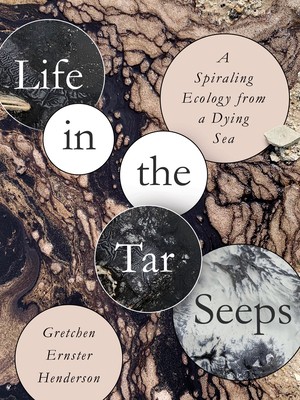
- We will send in 10–14 business days.
- Author: Gretchen Ernster Henderson
- Publisher: Trinity University Press
- ISBN-10: 1595342737
- ISBN-13: 9781595342737
- Format: 18.6 x 23.4 x 1.8 cm, minkšti viršeliai
- Language: English
- SAVE -10% with code: EXTRA
Reviews
Description
At Great Salt Lake, near Robert Smithson's iconic earthwork Spiral Jetty, a motley crew of scientists walks the mudflats to study fossils in the making. This reputedly dead sea is home to countless tar seeps, pools of raw oil that act as the perfect preservative, encasing organisms as they were in life.
In this spare landscape, an intricate web of life unfurls. Halophiles--salt-hungry microorganisms--tint the brackish water pink and orange; crystals of gypsum stud the ground, glistening underfoot; and pelicans and other migratory birds stop for a crucial rest. Barn owls and seagulls flirt with their prey around the oozing microbial constellations, sometimes falling prey to the oil themselves. Gretchen Henderson came to the tar seeps, a kind of natural asphalt, after recovering from being hit by a car as she walked in a crosswalk--a manufactured asphalt. Like the spiraling artwork that made the Great Salt Lake's northeastern shore famous, Henderson's associations of life and death, degeneration and regeneration, and injury and healing came together as she reexamined the pressing questions this delicate area revealed about the climate crisis. How do we move beyond narrow concepts of the beautiful and the ugly to care for ecosystems that evolve over time? How do we confront our vulnerability to recognize kindred dynamics in our living planet? Through shifting lake levels, bird migrations, microbial studies, environmental arts, and cultural histories shaped by indigenous knowledge and colonial legacies, Life in the Tar Seeps contemplates the ways others have understood this overlooked region. As Henderson witnesses scientists, curators, land managers, and students working collaboratively to steward a challenging place, she grows to see the lake not as dead but as a watershed for shifting perceptions and a meditation on the environmental healing of the planet. Henderson illustrates her journey with her own vivid photographs of tar seeps and pelican death assemblages, historic maps, and contemporary art and includes a wayfinding guide for exploring places of our own.EXTRA 10 % discount with code: EXTRA
The promotion ends in 23d.10:11:31
The discount code is valid when purchasing from 10 €. Discounts do not stack.
- Author: Gretchen Ernster Henderson
- Publisher: Trinity University Press
- ISBN-10: 1595342737
- ISBN-13: 9781595342737
- Format: 18.6 x 23.4 x 1.8 cm, minkšti viršeliai
- Language: English English
At Great Salt Lake, near Robert Smithson's iconic earthwork Spiral Jetty, a motley crew of scientists walks the mudflats to study fossils in the making. This reputedly dead sea is home to countless tar seeps, pools of raw oil that act as the perfect preservative, encasing organisms as they were in life.
In this spare landscape, an intricate web of life unfurls. Halophiles--salt-hungry microorganisms--tint the brackish water pink and orange; crystals of gypsum stud the ground, glistening underfoot; and pelicans and other migratory birds stop for a crucial rest. Barn owls and seagulls flirt with their prey around the oozing microbial constellations, sometimes falling prey to the oil themselves. Gretchen Henderson came to the tar seeps, a kind of natural asphalt, after recovering from being hit by a car as she walked in a crosswalk--a manufactured asphalt. Like the spiraling artwork that made the Great Salt Lake's northeastern shore famous, Henderson's associations of life and death, degeneration and regeneration, and injury and healing came together as she reexamined the pressing questions this delicate area revealed about the climate crisis. How do we move beyond narrow concepts of the beautiful and the ugly to care for ecosystems that evolve over time? How do we confront our vulnerability to recognize kindred dynamics in our living planet? Through shifting lake levels, bird migrations, microbial studies, environmental arts, and cultural histories shaped by indigenous knowledge and colonial legacies, Life in the Tar Seeps contemplates the ways others have understood this overlooked region. As Henderson witnesses scientists, curators, land managers, and students working collaboratively to steward a challenging place, she grows to see the lake not as dead but as a watershed for shifting perceptions and a meditation on the environmental healing of the planet. Henderson illustrates her journey with her own vivid photographs of tar seeps and pelican death assemblages, historic maps, and contemporary art and includes a wayfinding guide for exploring places of our own.

Reviews